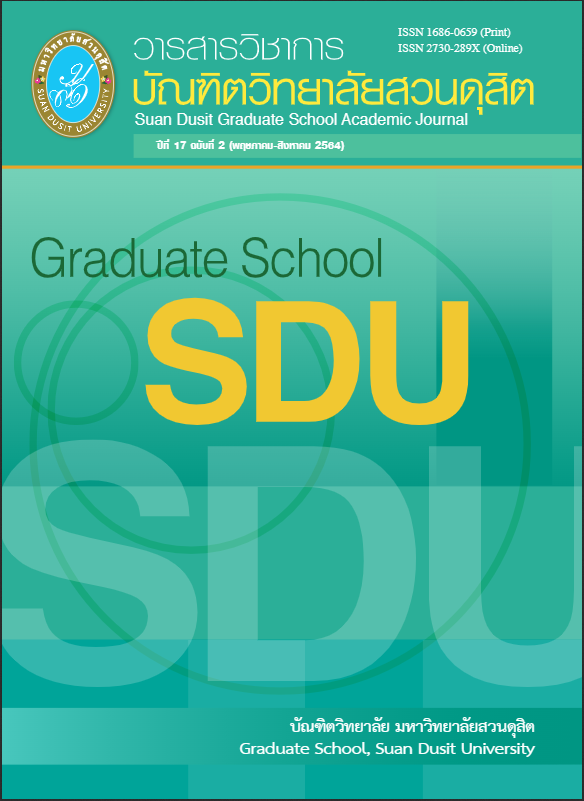A Study of Factors Affecting Measurement and Evaluation of Reading, Analytical Thinking, and Writing of the Basic Educational Schools, Affiliated with Bangkok Metropolitan Administration: Cross-Impact Analysis
Keywords:
Measurement and Evaluation of Reading, Analytical Thinking, and Writing, Cross-Impact AnalysisAbstract
The purposes of this research were to explore the conditions and problems of measurement and evaluation of reading, analytical thinking, writing and analyze factors affecting measurement and evaluation of reading, analytical thinking, and writing of the BMA basic educational schools by using cross-impact analysis. The sample group of this survey consisted of 450 teachers working at the BMA schools who were selected by stratified random sampling. The research tool was the questionnaires with the content validity of 0.60-1.00 and the reliability of 0.970-0.98 The key informants of the cross-impact analysis were 10 experts and university instructors recruited by purposive sampling. Quantitative data were analyzed by statistical description: percentage, mean, standard deviation, and Cross-Impact Analysis (Gordon, T.J. 1994).
Research findings revealed that operational conditions of measurement and evaluation of reading, analytical thinking, and writing of the BMA basic educational schools were high in reading, analytical thinking, and writing practice with the mean score of 3.35 and standard deviation of 0.50. The results of measurement and evaluation problems regarding reading, analytical thinking, and writing were low with the mean score of 1.30 and standard deviation of 1.03.
Findings from cross-impact analysis of factors affecting measurement and evaluation of reading, analytical thinking and writing indicated that the teachers' acknowledgement of the principles and operational guidelines of measurement and evaluation of reading, analytical thinking and writing highly affected the teachers' ability of using various techniques of measurement and evaluation of reading, analytical thinking and writing.
References
กระทรวงศึกษาธิการ, สำนักวิชาการและมาตรฐานการศึกษา. (2554). แนวปฏิบัติการวัดและประเมินผลการเรียนรู้ ตามหลักสูตรแกนกลางการศึกษาขั้นพื้นฐาน พุทธศักราช 2551 (พิมพ์ครั้งที่ 3). กรุงเทพฯ: ชุมนุมสหกรณ์การเกษตรแห่งประเทศไทย จำกัด.
เบญจพร ภิรมย์ และสมศักดิ์ ลิลา. (2554). ปัจจัยเชิงสาเหตุที่ส่งผลต่อความสามารถการคิดวิเคราะห์ของ นักเรียน ชั้นมัธยมศึกษาปีที่ 1 สังกัดสำนักงานเขตพื้นที่การศึกษาศรีสะเกษ เขต 1. ดุษฎีนิพนธ์สาขาวิชาวิจัย วัดผล และสถิติการศึกษา คณะศึกษาศาสตร์ มหาวิทยาลัยบูรพา.
ศรีแพร ผลบุญ. (2559). ปัจจัยการบริหารที่ส่งผลต่อการดำเนินงานตามนโยบายการพัฒนาการอ่านออกเขียนได้ ของนักเรียนในโรงเรียนสังกัดสำนักงานเขตพื้นที่การศึกษา ประถมศึกษานครพนม เขต 2. วิทยานิพนธ์ ปริญญาครุศาสตรมหาบัณฑิต สาขาวิชาการบริหารการศึกษา มหาวิทยาลัยราชภัฏสกลนคร.
Bloom, B. S. (1956). Taxonomy of Education Objective Handbook 1: Cognitive Domain. NY: David Mckey.
George, H. (2011). Teaching argument writing, grades 6-12: Supporting claims with relevant evidence and clear reasoning. Portsmouth, NH: Heinemann.
Gordon, T. J. (1994). Cross Impact Method. Technological report, United Nations University Millenniu Project.
Stover, J. and Gordon, T. J. (1978).). Cross Impact Analysis. Handbook of Futures Research. Jib Fowles, Greenwood Press.
Thaneerananon, T., Triampo, W., & Nokkaew, A. (2016). Denvelopment of a Test to Evaluate Students' Analytical Thinking Based on Fact versus Opinion Differentiation. International Journal of Instruction. 9 (2), p.123-138.
Downloads
Published
How to Cite
Issue
Section
License
Copyright (c) 2021 Suan Dusit Graduate School Acadamic Journal

This work is licensed under a Creative Commons Attribution-NonCommercial-NoDerivatives 4.0 International License.






